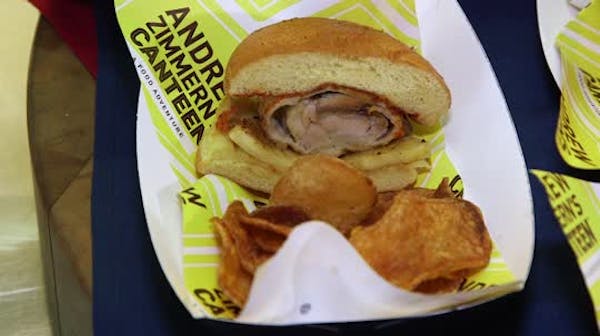St. Paul has its historic Mickey's Diner. And now Minneapolis has its Hi-Lo Diner.
The snazzy new Hi-Lo opened last week at Lake Street and 41st Avenue S., but it's actually not so new.
The building rolled off the line at the Fodero Dining Car Co. in New Jersey in 1957 — it's a modular structure that's designed to split down the center, lengthwise, not unlike a double-wide trailer home — and spent the next half-century as the Venus Diner in suburban Pittsburgh.
"That's the definition of a diner," said co-owner Mike Smith. "They're not site-built buildings. They're built in a factory, and shipped."
To the casual observer, the Venus (re-christened the Hi-Lo once it crossed the Mississippi) is a smile-inducing example of historic preservation, and no doubt the awards will follow. But beneath all that polished stainless steel lies a deeper purpose: crime prevention.
Smith and business partner James Brown grew tired of the break-ins at Forage Modern Workshop. The front door of their four-year-old furniture and home accessories store has been kicked in on eight occasions since 2012 and they wanted to add some protective eyes to the neighborhood.
They already owned the property across the street: It was home to one of the great visual scourges of our time, a derelict Taco Bell outlet from the 1980s.
What better replacement for an abandoned building than a busy diner, with a constant flow of upstanding citizens dropping in at all hours for pancakes, burgers, pie and trendy ice cream drinks?
And who better to restore one than Brown and Smith? Along with Forage, the duo also co-own Brownsmith Restoration, a general contractor specializing in historically accurate additions and renovations.
Brown discovered the Venus on the Internet (of course), the property of a Cleveland broker. Smith got on board in a nanosecond.
"All it took was one look for me to give him my one-word answer, and that was yes," he said with a laugh. Lacking restaurant experience, the duo quickly signed on friends and clients Jeremy Woerner and Pat McDonough, owners of the three Blue Door Pubs.
Little did any of them realize at the time that it would take nearly two years of patience and determination until the Venus finally arrived at 41st and Lake.
Preserving the past
Then the work really began. First up? Dealing with the buried remnants of a long-forgotten gas station that predated Taco Bell, and its expensive-to-deal-with contaminated soil.
"We built that into our costs," said Smith.
To make room for the Hi-Lo's kitchen — by design, it has always been a separate structure — Brown and Smith said "adios" to the Taco Bell building (a teardown party involved feeding Taco Bell takeout to 60 of their closest friends), most of which was carted away.
Most, but not all. A perfectly good walk-in cooler was preserved, along with a pair of exterior concrete block walls, which are now visible from what will soon be the Hi-Lo's 50-seat patio.
"We kept them up, in part, because we want to remind ourselves that we saved the city from another Taco Bell," said Smith. Amen to that.
In contrast to the flimsy architecture-as-junk-food that it replaced, the diner's durable materials — the exterior's polished stainless steel, for starters — have ensured a built-to-last legacy.
Brown and Smith spent nearly seven months painstakingly restoring the diner's curvaceous 68-seat interior (including a dozen along the counter) to its vaguely Art Deco-like beauty. It's a knockout.
A match to the turquoise-flecked terrazzo floor was crafted for the restroom lobby and vestibule. Original booth seating and counter stools were refurbished and reupholstered. OK, there's one holdover from the 1980s, a pair of Taco Bell chairs; don't blink or you'll miss them.
Original coat racks run the length of the dining room like so many sentinels. Tabletops were rebuilt, with new laminate covers and metal edging.
"But underneath they're the same table," said Smith. "Anything that we could fix, we kept. We're taking what was here, and trying not to mess it up."
In other words, they didn't hold themselves to strict museum-like fealty. After new light fixtures were scrounged from Architectural Antiques in Minneapolis, the original overhead lighting was scrapped.
"It was really harsh, super-bright fluorescents," said Smith. "I can't imagine it was ever pleasant at night, so we changed them out to LED lights, and now we can really dial up the mood."
An improved thoroughfare
The Hi-Lo is the latest enterprise to blossom along E. Lake Street, which has been in rejuvenation mode since 2008, when Hennepin County and the city of Minneapolis completed a much needed $31 million remake of the artery's streetscape.
The project started at the Mississippi River and stretched 4 miles west to Uptown, using trees, lamps and other pedestrian-friendly elements to transform the tired-looking thoroughfare.
Private investment eventually followed. As is the case with many urban revival stories, food is playing a central catalyst in E. Lake Street's slow-but-sure resurgence; witness the galvanizing appearance of independently owned restaurants, coffee shops and a supermarket, all breathing new life into formerly blighted or underused buildings.
Still, it's the Hi-Lo that's literally shining brightest, its gleaming looks the equivalent of Instagram catnip. Its rooftop sign (designed in Minneapolis by Paul Shively of Up & Onward, and built and installed by Bloomington-based Archetype) is another attention-grabber, cleverly calling upon neon to spell out an easy-to-remember moniker.
Hi-Lo is shorthand for two notable Minneapolis names, Hiawatha and Longfellow. But like all things Hi-Lo, there's an underlying reason: The verbal mash-up also rings with the abbreviated sound of a 1950s diner's name.
"The feel of a diner is so important," said Brown. "We wanted to make sure that the diner looks as if it has always been here."
Follow Rick Nelson on Twitter • @RickNelsonStrib
